
The London Transport TFsThis page created 19th February 1998, updated 24th September 2019.Introduction.The TF was the big step forward in LT single-decker design that bridged the gap between the revolutionary AEC Q class, with its offside engine, and the highly successful RF class of underfloor-engined buses and coaches. The last design to enter LT service before the second world war swept across Europe, the TF was caught up in the whirl-wind, with a lack of trained mechanics, and hiccups in the service for which it was designed. One sub-class, the private-hire TFs, was almost wiped out (with one survivor) in one bombing raid. But they withstood the exigencies of war-time, and were back in service on the revitalised Green Line services as soon as possible. They would have had much longer service lives with LT if it had not been for the policy of standardisation that saw the RF sweep away all other LT single deckers, carrying away the TFs along with the 10T10s in the early fifties.The prototype: 1TF1, TF1, C34C, Total 1The prototype was revolutionary with its chassis, and bold with its bodywork.The chassis, by Leyland, was the Tiger FEC - which bore little if any relationship to the contemporary PS Tigers. It would, however, have been recognized in its layout thirty years later, when underfloor mid-engined coaches were common-place. Presumably FEC stood for Floor Engine Compartment. The idea was to obtain the maximum coach seating within the statutory limitations of a 27ft 6in by 7ft 6in body, without transverse-facing seating. The Q had suffered from the latter, with its mid-side engine, but the TF had its engine under a high floor (no SLFs then!). The sliding door was to go behind the front wheels, which were nearly at the front of the chassis. The wheelbase, at 18ft 6in, was a foot longer than the contemporary 10T10s. TF1 had single tyres on all wheels. For the technically minded, the underfloor engine was a Leyland 8.6 litre diesel, coupled through an AEC pneumatic gearbox. The vehicle was delivered to Chiswick in July 1937. 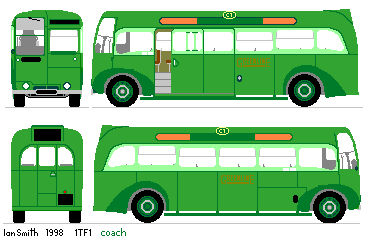
The Chiswick-designed Leyland body that fitted onto this chassis looked
unlike anything that had gone before, and had a strong art-deco feel to it.
Actually the changes were mainly at the front end,
the rear being very similar to the 9T9 body, with a stepped window-line.
But at the front the driver was perched very high in a half-cab glass-house.
Livery was three-tone green, with Green Line fleetnames. It had seats for 34 passengers.
TF1 went into service in early December 1937, from Tunbridge Wells (TW) on routes C1 and C2,
but was transfered later in the month to Romford, in preparation for the allocation of the production GreenLine coaches.
Like other Greenline coaches it was withdrawn at the outbreak of war, but unusually went into store at Chiswick. It was overhauled in 1940, emerging similar in appearance to the production greenline TFs. It was given some duties in London (Green Park). It wound up in the Private Hire fleet at Old Kent Road (P) for a while, then worked at Merton (AL) and Sidcup (SP). It was overhauled again at the end of 1942, but then went into store. TF1 was sold in January 1946, passing from Henry Lane to Castle Coaches of Lewisham, who hired it back to London Transport for service during the 1946 vehicle shortages.
The private hire TFs: 2TF3, TF2-13, C33C, Total 12Park Royal won the contract to body a dozen TFs for London sightseeing and private hire work. This was in the hands of the solid Renowns (LTCs), plus a motley collection of surviving coaches from the GreenLine fleet, including five Leyland Tigers and eight coach Regals. Also displaced was the only real coach in the fleet, LT 1429, the luxurious and stylish Harrington bodied Renown acquired with the business of Hillmans of Romford.
The Green Line TFs: 2TF2, TF14-88, C34C, Total 75The Green Line TFs had Leyland FEC chassis with Chiswick coach-work. The design was tidied up somewhat, with a straight bottom edge to the window-line and a radiator built in to the curved nearside front wing. A remaining oddity was the upsweep in the gutter line, matching the coach-roof-boards. Presumably this avoided breaking the gutter for the fixing points, but it produced an untidy effect when different length boards were used, or in the latter days when they were demoted to bus work. They were handsome machines, with a favoured twin seat at the nearside front.
When the post-war GreenLine services resumed, during 1946, the Romford services retained double-deckers, in the form of austerity Daimlers plus some STLs. So the TFs went to Dorking (712/3/4 + 412), St Albans (712/3), Grays (723+375), Epping (720) and Luton (727).
The TF allocations remained fairly stable. The 727 and 714 were joined together between Baker Street and Kings Cross in September 1951, as a revised 714 between Dorking and Luton, and a new 723A was added in July 1951 to serve new estates at Aveley.
TF77, preserved in the LT Museum, Covent Garden, London, in 1998.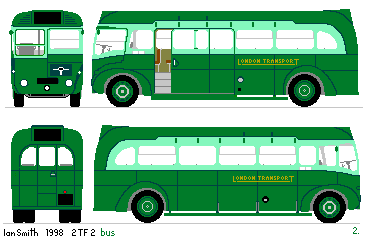
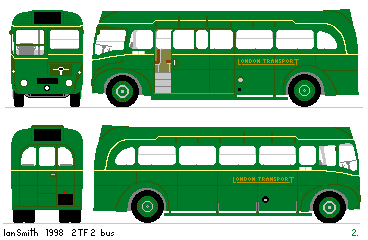 At first the displaced TFs retained the two-tone green livery,
but some later received overall Lincoln green with cream lining.
At first the displaced TFs retained the two-tone green livery,
but some later received overall Lincoln green with cream lining.
The respite in Country Bus work was short-lived however, as the
Country RFs followed.
St Alban's, a TF redoubt, lost them in April and May 1953.
May also saw Hertford's allocation go, followed by Hitchin and Luton in June.
Epping saw the last of its TFs at this time too,
as they were replaced by
10T10s from elsewhere.
Similarly Grays received postwar Regals,
15T13s, for its bus work.
SurvivorsTF 77 is active in the London Transport collection.TF 43: the chassis frame was in service on Malta, with a replacement body, a front-mounted engine and Bedford axles/wheels! TF77 with RT44 at Stratford Rally, 1970. Photo by Ian Smith. |
 TF1 history summary
TF1 history summary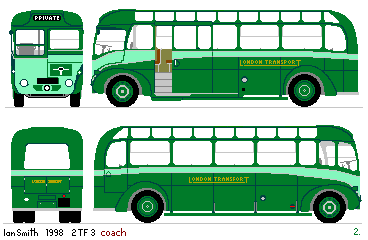 The new coaches were on the updated 2TF chassis, with a radiator built into the nearside front wing.
The Park Royal bodies had metal framing, essential in the light of the amount of glazing.
They had deep side windows, glazed quarterlights and an opening canvas roof
almost the whole length of the saloon. There was nothing quite like them as a city viewing platform
until the seventies craze for open-toppers.
They also had a radio, with roof-mounted aerials. An offside emergency door cost a pair of seats,
but allowed a rear aspect unlike anything on LT before or since.
Livery was a two-tone green applied in sweeping curves.
(The post-war survivor went into Lincoln Green and flake grey, like the private-hire RFs).
The new coaches were on the updated 2TF chassis, with a radiator built into the nearside front wing.
The Park Royal bodies had metal framing, essential in the light of the amount of glazing.
They had deep side windows, glazed quarterlights and an opening canvas roof
almost the whole length of the saloon. There was nothing quite like them as a city viewing platform
until the seventies craze for open-toppers.
They also had a radio, with roof-mounted aerials. An offside emergency door cost a pair of seats,
but allowed a rear aspect unlike anything on LT before or since.
Livery was a two-tone green applied in sweeping curves.
(The post-war survivor went into Lincoln Green and flake grey, like the private-hire RFs).
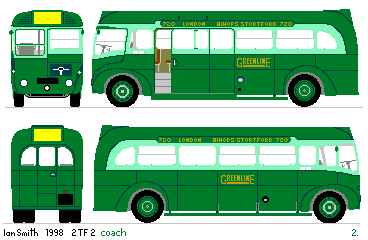 They were built during 1939, the chassis having been delivered by
Leyland before Chiswick was ready to build the bodies. The entire
batch of 75 was allocated to Romford for the heavily loaded
services to Aldgate. Of course, shortly after their arrival, these
Green Line services were suspended, and the TFs re-allocated to
ambulance duties. When the Romford services were allowed to
restart in 1940 they used STLs for capacity, so the TFs remained
on ambulance work throughout the war.
They were built during 1939, the chassis having been delivered by
Leyland before Chiswick was ready to build the bodies. The entire
batch of 75 was allocated to Romford for the heavily loaded
services to Aldgate. Of course, shortly after their arrival, these
Green Line services were suspended, and the TFs re-allocated to
ambulance duties. When the Romford services were allowed to
restart in 1940 they used STLs for capacity, so the TFs remained
on ambulance work throughout the war.
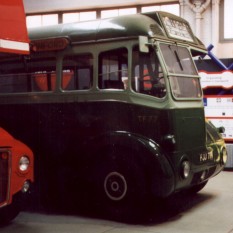
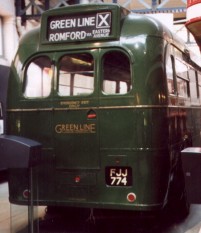
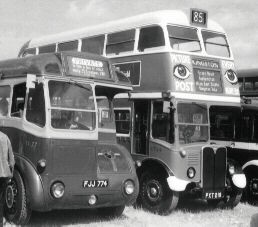
 Ian's Bus Stop
Ian's Bus Stop 10T10s
10T10s TF text
TF text